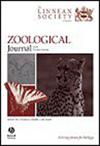欧亚大陆西部蹄甲目(腹足纲:蹄甲目:Clausiliidae)的系统发育和分化
IF 3
2区 生物学
Q1 ZOOLOGY
引用次数: 0
摘要
鲜为人知的欧亚大陆西部Phaedusinae(陆地蜗牛科Clausiliidae)类群是第三纪的遗民,与欧亚大陆东部的其他亚科在地理上相距甚远。为了阐明该亚科的系统发育关系,我们利用核基因序列对 16 个属中的 11 个属进行了分子分析。结果表明,在该亚科中,Nothoserrulina 和 Pamphylica 与 Caspiophaedusa、Dobatia、Pravispira 和 Serrulina 同属一个支系,该支系与除 Synprosphyma 以外的所有东欧亚 Phaedusinae 是姐妹支系。与此相反,Graecophaedusa、Laeviphaedusa、Pontophaedusella 和 Serrulinella 与 Pontophaedusa 属于旁支系,在这些支系的分支点与最基干的 Synprosphyma 支系的分支点之间发生分化。Laeviphaedusa和Pontophaedusella代表了欧亚大陆西部最早的支系,估计可追溯到始新世-更新世边界。将我们的系统发生与这些属的形态特征进行比较,确定了贝壳和生殖器官的支系特异性。根据化石记录以及古地理和古植物学数据,我们还提出了该亚科在欧亚大陆的地理起源和辐射模型。本文章由计算机程序翻译,如有差异,请以英文原文为准。
The phylogeny and diversification of the western Eurasian Phaedusinae (Gastropoda: Stylommatophora: Clausiliidae)
The little-known western Eurasian taxa of the Phaedusinae (land snail family Clausiliidae) are Tertiary relicts, which are widely separated geographically from the rest of the subfamily occurring in eastern Eurasia. In order to elucidate the phylogenetic relationships of this group, we carried out molecular analyses with 11 of the 16 genera using nuclear gene sequences. Our results revealed that within the subfamily, Nothoserrulina and Pamphylica, together with Caspiophaedusa, Dobatia, Pravispira, and Serrulina, belong to a clade that is sister to that of all east Eurasian Phaedusinae except Synprosphyma. In contrast, Graecophaedusa, Laeviphaedusa, Pontophaedusella, and Serrulinella, together with Pontophaedusa, belong to paraphyletic lineages diverging between the branching point of these clades and that of the most basal Synprosphyma lineage. Laeviphaedusa and Pontophaedusella represent the earliest western Eurasian lineages, estimated to date back to the Eocene–Oligocene boundary. Comparison of our phylogeny to morphological traits of the genera identified clade-specific character states of the shells and the reproductive organs. Based on fossil records and on palaeogeographical and palaeofloristic data, we also propose a model for the geographical origin and radiation of this subfamily in Eurasia.
求助全文
通过发布文献求助,成功后即可免费获取论文全文。
去求助
来源期刊
CiteScore
6.50
自引率
10.70%
发文量
116
审稿时长
6-12 weeks
期刊介绍:
The Zoological Journal of the Linnean Society publishes papers on systematic and evolutionary zoology and comparative, functional and other studies where relevant to these areas. Studies of extinct as well as living animals are included. Reviews are also published; these may be invited by the Editorial Board, but uninvited reviews may also be considered. The Zoological Journal also has a wide circulation amongst zoologists and although narrowly specialized papers are not excluded, potential authors should bear that readership in mind.

 求助内容:
求助内容: 应助结果提醒方式:
应助结果提醒方式:


